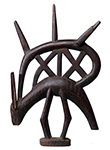This page is a record of an exhibit that took place in 2003. The individual links below will take you to the CURRENT VERSION of the pages that formed part of that exhibit. |
NEW CATALOG ONLINE of this exhibition, Follow links below for images,
sizes, prices and more information.
Four exciting and varied groups of works are featured in our fourth summer
selections exhibition.
Moba diviners influence and direct the planning, design and ritual use of tchitcheri figures for family or clan shrines. They are protective and promote health and prosperity. Representing no particular person or ancestor, they are an individual's direct link with God. The figure is reduced to an elemental, symbolic form, with rare facial features, hands, feet or gender. Moba Tchitcheri figures from Togo are classified by size and intended use: Yendu are small wood or metal figures on personal altars; Bavong are medium-sized and depict ancestors for family altars; Sakab are large and depict the clan founder, and are placed outside protecting the whole village.
The serpent, Kakilambe, is a protective spirit that presides over young men's initiation camps. It appears in the village on ritual days and to announce the return of the boys as men. They range from the symmetrical and totemic to wildly undulating from side to side and front to back. Some versions are also worn as headdresses called Bansonyi, they were protective and appeared at initiation ceremonies.
Bamana Chi Wara from Mali, represent and honor the mythological half man / half antelope hero who taught man how to cultivate the soil. They were danced in pairs and celebrate the union of male (sun), female (earth) and fibre costume (rain), signifying the cooperation needed for a successful harvest and community survival. They are worn as headdresses and danced as pairs. Spelled alternately Ci Wara, Tyi Wara, etc. they illustrate the diversity of ways to represent an unwritten pronunciation. There are three types of Chi Wara headdresses; the familiar vertical style of the eastern Bamana, the more realistic horizontal style of the northern Bamana and the varied and more abstract forms of the Southern Bamana. These are examples of the eastern vertical style.

These are female examples of the eastern vertical style.
These are male examples of the eastern vertical style.
These are paired examples of the eastern vertical style.
These are examples of the northern horizontal style.

These are examples of the the varied and more abstract forms of the Southern Bamana.
Bamana Chi Wara from Mali, represent and honor the mythical being that taught the Bamana to farm. They are worn as headdresses and danced as pairs. Spelled alternately Ci Wara, Tyi Wara, etc. they illustrate the diversity of spellings to represent an unwritten pronunciation. There are three types of Chi Wara headdresses; the familiar vertical style of the eastern Bamana, the more realistic horizontal style of the northern Bamana and the varied and more abstract forms of the Southern Bamana.
These forged iron Chi-waras (antelope figures) lance and mask exhibit the technical skill and artistry that Bamana blacksmiths brought to their work. They would do the smelting to get the iron from iron ore, then heat and hammer out both the tools and weapons used and the important ritual objects.
Kuba skirts are commonly made from raffia. These unusual pieces incorporate assembled or painted barkcloth, with abstract patterns similar to those on their barkcloth costumes. The edges are trimmed with raffia pieces, tufting, batik and embroidery.
TRIBE |
OBJECT |